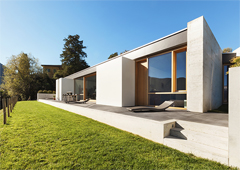There’s been a lot of buzz recently about the zero-energy building trend, especially in California, which recently mandated that all new residential buildings must be built to zero-net energy specifications by 2020. If you’re not up-to-speed with the zero-energy building concept — relying on a home’s extraordinary energy conservation and on-site renewable energy to meet heating, cooling and energy needs — here is some info from RIS Media on what you can expect to see when builders start taking green homes to a whole new level:
• These high-performance homes will produce as much energy as they consume by incorporating a photovoltaic system (a linked collection of solar panels) — or other renewables — into the mix. With the majority of these homes still connected to the grid, any excess energy that’s accumulated throughout the day is fed back to the grid, so it can be used at night or on cloudy days.
• Not only are zero-energy homes designed and built as energy-efficiently as possible, residents can look forward to zero energy bills — other than the monthly fee required to connect to the grid — and zero carbon emissions.
• While zero-energy homes look like any other home from the outside, their exterior walls tend to be thicker than those found in traditional homes. They also incorporate heating and cooling systems that are a lot more efficient than typical systems, affording homeowners the luxuries they would expect in a home today.
